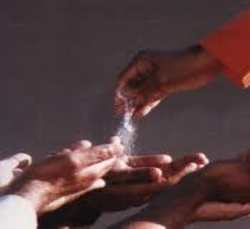Agregados
Vol 16 Número 5
Setiembre / Octubre 2025
1. Artículo de salud
¡Nuestra fuerza vital es nuestra sangre! ¡Cuídate!
Mucho trabajo se realiza en las células sanguíneas, incluso en las células más pequeñas. ¡Nadie puede comprender el misterio de la creación! El cuerpo está lleno de células sanguíneas. Lo que está presente en una sola célula también está presente en las demás. Cada célula activa y embellece el cuerpo y se sacrifica por las demás, enseñando la lección del sacrificio a la humanidad; el bienestar reside en el sacrificio. Hay sangre circulando en la mano. A cada instante, la sangre sale de la mano y se dirige a otras partes; es sacrificio. Si la sangre no se sacrifica y fluye, se coagula, provocando la formación de forúnculos y enfermedades. El bienestar de la mano reside en el sacrificio de la sangre, ¿no es así? El sacrificio es necesario si uno quiere progresar en la vida; nos lleva a la inmortalidad.…Sathya Sai Baba 1
2 anterior , exploramos cómo un corazón sano está en nuestras manos. En este número, nos centramos en la sangre vital que bombea incansablemente, fluyendo por nuestros vasos sanguíneos como un río silencioso, sustentando la vida.
1. Componentes de la sangre
1.1 La sangre es un fluido especializado que actúa como el principal sistema de transporte del cuerpo. Está compuesta por cuatro componentes 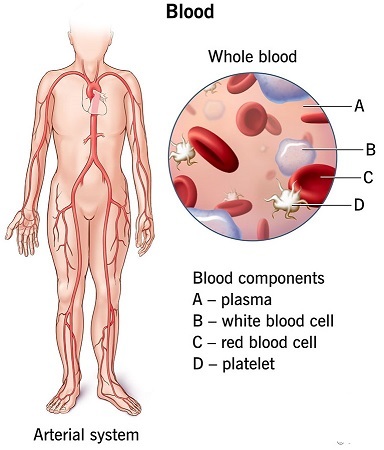 principales: plasma y glóbulos rojos. (GR), glóbulos blancos (GB) y plaquetas (PLT), cada uno de los cuales desempeña un papel crucial. Un hombre de tamaño promedio tiene alrededor de 5 litros de sangre en su cuerpo y una mujer tiene alrededor de 4 litros, lo que constituye entre el 7% y el 8% de su peso corporal. 3,4
principales: plasma y glóbulos rojos. (GR), glóbulos blancos (GB) y plaquetas (PLT), cada uno de los cuales desempeña un papel crucial. Un hombre de tamaño promedio tiene alrededor de 5 litros de sangre en su cuerpo y una mujer tiene alrededor de 4 litros, lo que constituye entre el 7% y el 8% de su peso corporal. 3,4
1.2 El plasma, la parte líquida de la sangre y su componente más importante (55%), se compone principalmente de agua absorbida de los alimentos y bebidas que consumimos. Es una mezcla de 92% de agua, 7% de proteínas vitales  (albúmina, globulina, fibrinógeno) y 1% de azúcar, grasa, sales, hormonas y nutrientes producidos en el hígado y otros órganos. Los otros tres componentes de la sangre flotan en este líquido. El plasma desempeña un papel fundamental en la circulación y el transporte de las células sanguíneas por todo el cuerpo, junto con nutrientes, hormonas y proteínas vitales. También ayuda a mantener la temperatura corporal, la presión arterial, el sistema inmunitario, el equilibrio de líquidos y pH, y transporta los productos de desecho para su eliminación. 3-6
(albúmina, globulina, fibrinógeno) y 1% de azúcar, grasa, sales, hormonas y nutrientes producidos en el hígado y otros órganos. Los otros tres componentes de la sangre flotan en este líquido. El plasma desempeña un papel fundamental en la circulación y el transporte de las células sanguíneas por todo el cuerpo, junto con nutrientes, hormonas y proteínas vitales. También ayuda a mantener la temperatura corporal, la presión arterial, el sistema inmunitario, el equilibrio de líquidos y pH, y transporta los productos de desecho para su eliminación. 3-6
1.3 Los glóbulos rojos ( eritrocitos ) son las células más abundantes en la sangre (44 %), con una vida útil de 120 días. Contienen hemoglobina (Hb), una combinación de proteína especial y hierro, que transporta el oxígeno desde los pulmones al resto del cuerpo y devuelve el dióxido de carbono para su exhalación. El cuerpo obtiene la mayor parte del hierro necesario del hígado, el bazo, la médula ósea y los glóbulos rojos viejos reciclados. 3 , 4, 7, 8
1.4 Los leucocitos ( GB ) son los guerreros que siempre están alerta para proteger al cuerpo de las infecciones y ocupan menos del 1% de la sangre. 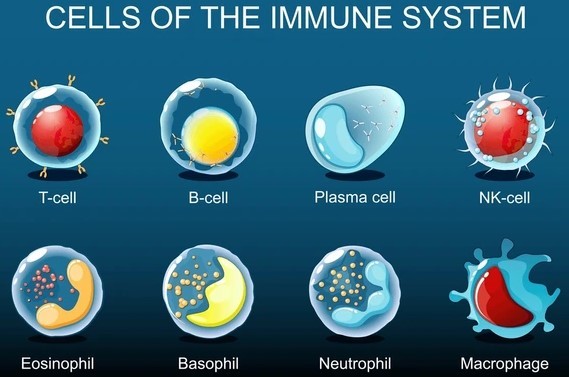 El tipo más común, que constituye más de la mitad de los GB, son los neutrófilos , la primera línea de defensa del cuerpo contra infecciones bacterianas y fúngicas, con la ayuda de los eosinófilos y los basófilos . Los GB que se encargan de la inmunidad a largo plazo son los linfocitos , con sus potentes células T y B para atacar a los patógenos, con la ayuda de los monocitos para eliminar los residuos. 3,4,9
El tipo más común, que constituye más de la mitad de los GB, son los neutrófilos , la primera línea de defensa del cuerpo contra infecciones bacterianas y fúngicas, con la ayuda de los eosinófilos y los basófilos . Los GB que se encargan de la inmunidad a largo plazo son los linfocitos , con sus potentes células T y B para atacar a los patógenos, con la ayuda de los monocitos para eliminar los residuos. 3,4,9
1.5 Las plaquetas ( trombocitos ) son diminutos fragmentos celulares con una vida útil de 5 a 9 días. Al sufrir un corte o una lesión, acuden rápidamente al 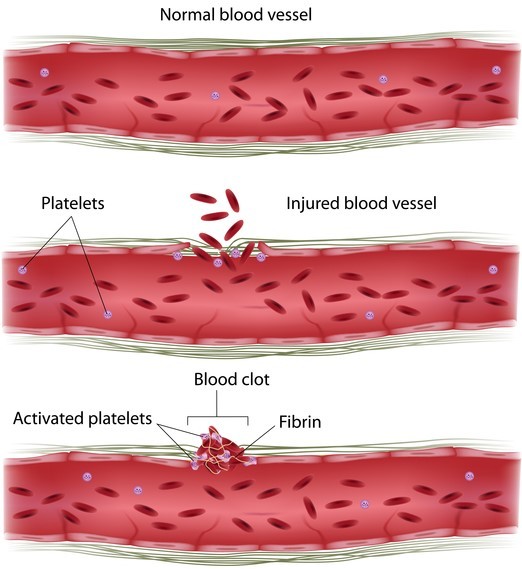 lugar, se adhieren y desencadenan el proceso de coagulación. Esto crea una red de fibrina pegajosa que tapona la herida y detiene el sangrado; esta red actúa como un soporte temporal donde puede crecer tejido nuevo, lo que facilita la cicatrización de la herida. 3,4,10
lugar, se adhieren y desencadenan el proceso de coagulación. Esto crea una red de fibrina pegajosa que tapona la herida y detiene el sangrado; esta red actúa como un soporte temporal donde puede crecer tejido nuevo, lo que facilita la cicatrización de la herida. 3,4,10
2. La creación de la sangre
2.1 La médula ósea, la inimitable fábrica de células sanguíneas , es un tejido esponjoso y gelatinoso que se encuentra en el centro de ciertos huesos, 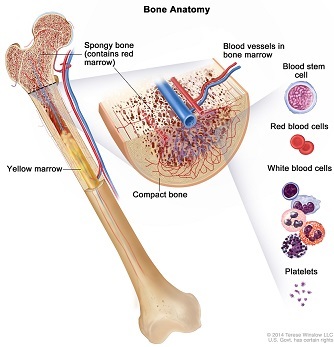 principalmente las costillas, la columna vertebral, la pelvis y el esternón. Existen dos tipos de médula ósea: la médula ósea roja , que produce sangre, y la médula ósea amarilla , que almacena principalmente grasa, pero también puede contribuir a la formación de huesos, cartílagos y músculos. En la médula ósea roja, la sangre comienza como diminutas células madre . En aproximadamente una semana, estas maduran en tres tipos esenciales de células sanguíneas: glóbulos rojos, glóbulos blancos y plaquetas. La médula ósea incorpora estas células sanguíneas al plasma, convirtiéndolo en sangre completa que fluye por nuestras venas y arterias.
principalmente las costillas, la columna vertebral, la pelvis y el esternón. Existen dos tipos de médula ósea: la médula ósea roja , que produce sangre, y la médula ósea amarilla , que almacena principalmente grasa, pero también puede contribuir a la formación de huesos, cartílagos y músculos. En la médula ósea roja, la sangre comienza como diminutas células madre . En aproximadamente una semana, estas maduran en tres tipos esenciales de células sanguíneas: glóbulos rojos, glóbulos blancos y plaquetas. La médula ósea incorpora estas células sanguíneas al plasma, convirtiéndolo en sangre completa que fluye por nuestras venas y arterias.
Después de los siete años, la médula ósea amarilla aumenta gradualmente, especialmente durante las dos primeras décadas de vida. Como un sistema de respaldo integrado, en momentos de gran necesidad, como pérdida de sangre, infección grave o fiebre, la médula ósea amarilla puede transformarse nuevamente en médula ósea roja , impulsando la producción de glóbulos rojos hasta que se restablezca el equilibrio. 11,12
2.2 Las células madre son células especiales que se encuentran en diferentes partes del cuerpo: la médula ósea, la sangre, el cerebro, la piel y el corazón; también en el embrión en 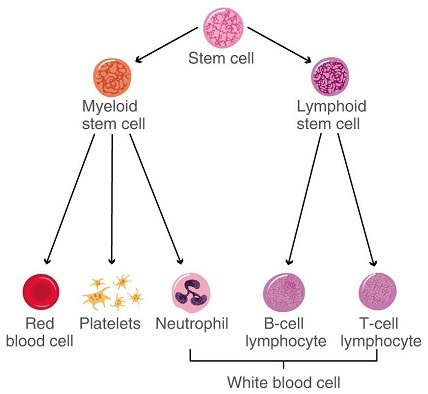
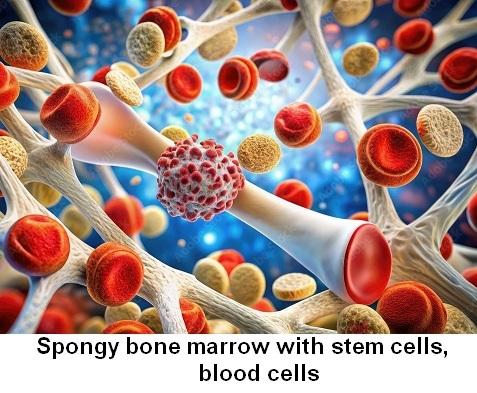 themselves and etapa temprana (de 3 a 5 días), el cordón umbilical y la placenta de los recién nacidos. Su singularidad reside en su capacidad de replicarse, renovarse, reparar y reemplazar las células dañadas. A nivel mundial, se está realizando una amplia investigación sobre células madre para comprender cómo se desarrollan las enfermedades, crear células sanas que puedan tratar y curar diferentes enfermedades consideradas incurables hoy en día, y evaluar la seguridad y eficacia de nuevos medicamentos. 13-15
themselves and etapa temprana (de 3 a 5 días), el cordón umbilical y la placenta de los recién nacidos. Su singularidad reside en su capacidad de replicarse, renovarse, reparar y reemplazar las células dañadas. A nivel mundial, se está realizando una amplia investigación sobre células madre para comprender cómo se desarrollan las enfermedades, crear células sanas que puedan tratar y curar diferentes enfermedades consideradas incurables hoy en día, y evaluar la seguridad y eficacia de nuevos medicamentos. 13-15
3. Importancia del análisis de sangre
Un análisis de sangre muestra el estado general de salud, detecta problemas de salud o indica si se necesitan más pruebas para un diagnóstico preciso. Los pacientes también controlan su estado mediante pruebas periódicas de diabetes, función tiroidea, hepática y renal, deficiencia de vitaminas, alergias, infecciones, cáncer y trastornos autoinmunes. El análisis de sangre más común es el hemograma completo, que mide los niveles de glóbulos rojos, glóbulos blancos, hemoglobina y plaquetas, además de otros parámetros. Estos pueden variar según el sexo, la edad y la afección; el rango normal también varía ligeramente según el laboratorio que lo analice. 16-21
4. Es bueno saber nuestro tipo de sangre
Los componentes y funciones de la sangre son los mismos para todos, independientemente del tipo de sangre. Los tipos de sangre se clasifican en el 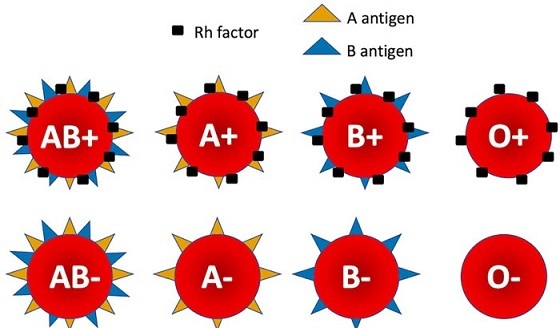 sistema ABO : A, B, AB u O, según si los glóbulos rojos (GR) portan el antígeno A, el antígeno B, ambos o ninguno. Un antígeno actúa como un marcador que el sistema inmunitario reconoce y responde. Cada grupo se clasifica, a su vez, como positivo o negativo según la presencia de otro marcador, el factor Rh (antígeno D). Esto da un total de ocho tipos de sangre: A+, A–, B+, B–, AB+, AB–, O+ y O–. Esta clasificación es vital para garantizar la compatibilidad en transfusiones de sangre, donación de órganos, embarazo y evaluación de ciertos riesgos para la salud. 22-23
sistema ABO : A, B, AB u O, según si los glóbulos rojos (GR) portan el antígeno A, el antígeno B, ambos o ninguno. Un antígeno actúa como un marcador que el sistema inmunitario reconoce y responde. Cada grupo se clasifica, a su vez, como positivo o negativo según la presencia de otro marcador, el factor Rh (antígeno D). Esto da un total de ocho tipos de sangre: A+, A–, B+, B–, AB+, AB–, O+ y O–. Esta clasificación es vital para garantizar la compatibilidad en transfusiones de sangre, donación de órganos, embarazo y evaluación de ciertos riesgos para la salud. 22-23
5. Trastornos de la sangre
La mayoría de los trastornos relacionados con la sangre se deben a un mal funcionamiento de la médula ósea que provoca una producción insuficiente o excesiva de glóbulos rojos, glóbulos blancos o plaquetas, debido a afecciones médicas o causas desconocidas. 24
5.1 Los trastornos relacionados con el plasma pueden afectar la coagulación sanguínea, la lucha contra las infecciones o el mantenimiento del 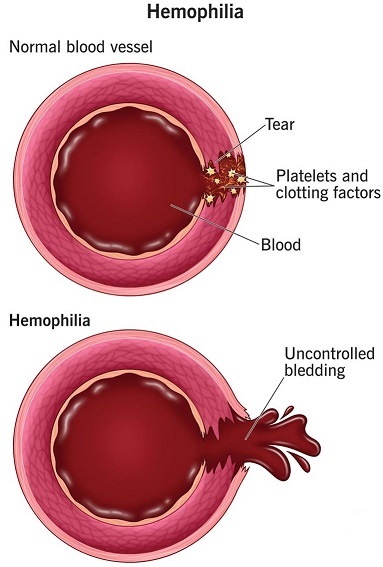 equilibrio hídrico. Un nivel elevado de grasa o colesterol en el plasma, la hiperlipidemia , aumenta el riesgo de cardiopatías y accidentes cerebrovasculares. Un nivel bajo de proteínas en el plasma, la hipoproteinemia, puede causar inflamación, debilitamiento del sistema inmunitario y una cicatrización lenta. Un trastorno genético poco común, la hemofilia , se produce cuando el plasma carece de factores de coagulación, lo que provoca hematomas con facilidad, sangrado prolongado por cortes pequeños y hemorragias nasales repentinas. 25-27
equilibrio hídrico. Un nivel elevado de grasa o colesterol en el plasma, la hiperlipidemia , aumenta el riesgo de cardiopatías y accidentes cerebrovasculares. Un nivel bajo de proteínas en el plasma, la hipoproteinemia, puede causar inflamación, debilitamiento del sistema inmunitario y una cicatrización lenta. Un trastorno genético poco común, la hemofilia , se produce cuando el plasma carece de factores de coagulación, lo que provoca hematomas con facilidad, sangrado prolongado por cortes pequeños y hemorragias nasales repentinas. 25-27
5.2 Trastornos de los glóbulos rojos: La anemia 21 es el trastorno sanguíneo más común, generalmente causado por un recuento bajo de 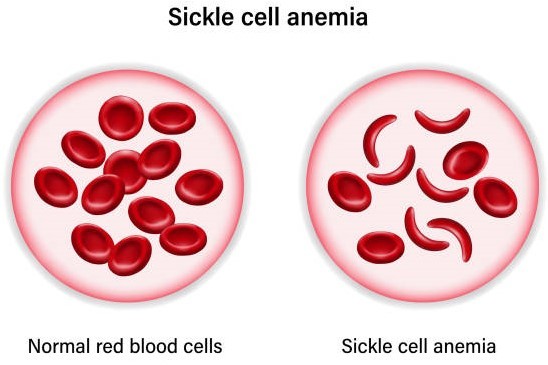
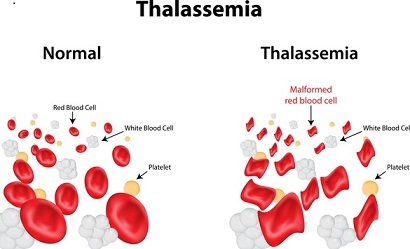
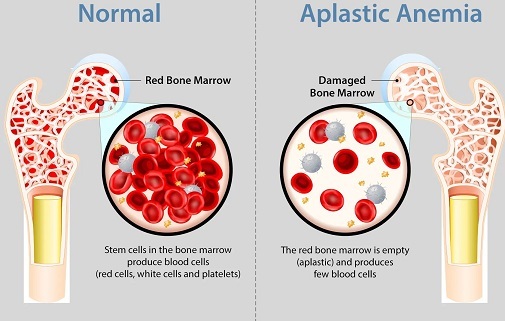 hemoglobina (Hb) o una cantidad insuficiente de glóbulos rojos. Esto suele deberse
hemoglobina (Hb) o una cantidad insuficiente de glóbulos rojos. Esto suele deberse  a una mala nutrición, deficiencia de vitaminas o ciertas enfermedades. Los síntomas incluyen cansancio, debilidad, dificultad para respirar, mareos, palidez y frío u hormigueo en manos y pies. 28 Algunas formas son hereditarias, como la anemia de células falciformes , en la que los glóbulos rojos deformados obstruyen el flujo sanguíneo y causan dolor, y la talasemia , en la que el cuerpo produce menos Hb y glóbulos rojos más pequeños. Otro tipo poco común, la anemia aplásica , se produce cuando la médula ósea dañada no produce suficientes glóbulos rojos. 28-31
a una mala nutrición, deficiencia de vitaminas o ciertas enfermedades. Los síntomas incluyen cansancio, debilidad, dificultad para respirar, mareos, palidez y frío u hormigueo en manos y pies. 28 Algunas formas son hereditarias, como la anemia de células falciformes , en la que los glóbulos rojos deformados obstruyen el flujo sanguíneo y causan dolor, y la talasemia , en la que el cuerpo produce menos Hb y glóbulos rojos más pequeños. Otro tipo poco común, la anemia aplásica , se produce cuando la médula ósea dañada no produce suficientes glóbulos rojos. 28-31
La policitemia, un recuento elevado de glóbulos rojos, puede ser consecuencia de enfermedades cardíacas o pulmonares, el uso de esteroides, el tabaquismo, la altitud elevada o la deshidratación. Puede progresar a policitemia vera , un cáncer de la sangre en el que la médula ósea produce un exceso de glóbulos rojos, lo que espesa la sangre y aumenta el riesgo de coágulos sanguíneos, infarto de miocardio o accidente cerebrovascular. Generalmente se observa después de los 60 años; sus síntomas incluyen picazón en la piel, zumbido de oídos, dolor abdominal, hemorragia nasal y visión borrosa o doble. 28,32
5.3 Trastornos de los leucocitos: La leucemia es un cáncer de sangre típico en el que la médula ósea produce un exceso de leucocitos anormales, 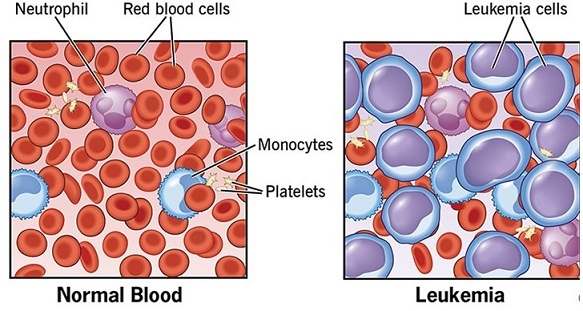
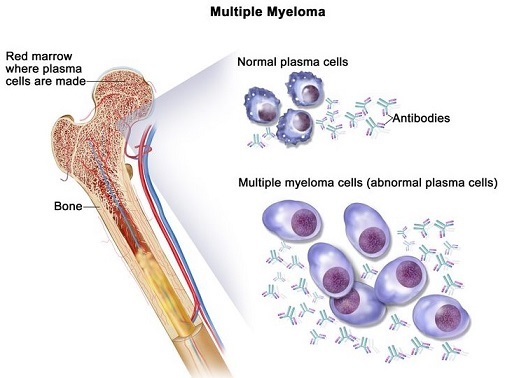 desplazando a las células sanas y reduciendo la inmunidad. Los síntomas suelen incluir fiebre, dolores corporales, heridas de cicatrización lenta, infecciones frecuentes y tos persistente o problemas respiratorios; lo mismo ocurre cuando el recuento de leucocitos es bajo ( leucopenia ), lo que resulta en una inmunidad reducida. 33-35
desplazando a las células sanas y reduciendo la inmunidad. Los síntomas suelen incluir fiebre, dolores corporales, heridas de cicatrización lenta, infecciones frecuentes y tos persistente o problemas respiratorios; lo mismo ocurre cuando el recuento de leucocitos es bajo ( leucopenia ), lo que resulta en una inmunidad reducida. 33-35
En el mieloma múltiple , la médula ósea produce células plasmáticas anormales (un tipo de leucocitos), lo que causa dolor óseo, propensión a la formación de hematomas, ritmo cardíaco irregular e infecciones frecuentes. Una forma más leve y temprana, llamada GMSI , puede ser asintomática, pero en ocasiones puede volverse cancerosa. 36
5.4 Trastornos plaquetarios: La trombocitopenia, cuando el recuento de plaquetas es inferior a lo normal, puede provocar sangrado abundante. Los 
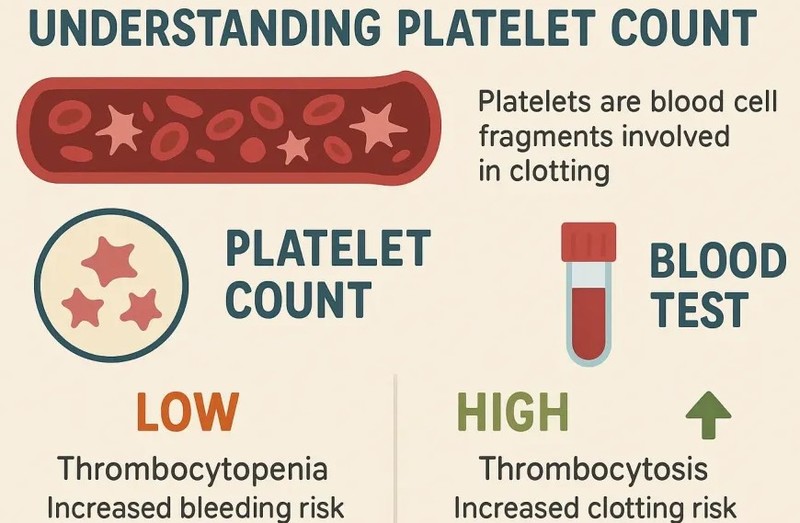 síntomas incluyen hematomas, hemorragia nasal o encías frecuentes, sangre en las heces, hemorragia interna, sangrado menstrual abundante, agrandamiento del bazo, dolor muscular y articular, y hormigueo en manos y pies.
síntomas incluyen hematomas, hemorragia nasal o encías frecuentes, sangre en las heces, hemorragia interna, sangrado menstrual abundante, agrandamiento del bazo, dolor muscular y articular, y hormigueo en manos y pies.
Hinchazón en las piernas, fuertes dolores de cabeza, debilidad o mareos. La trombocitosis, cuando el recuento de plaquetas es superior a lo normal, puede causar una coagulación innecesaria que puede provocar un derrame cerebral o un infarto. La disfunción plaquetaria implica que el recuento es normal, pero no funciona como se espera. 37
5.5 Otros trastornos sanguíneos : Un hematoma es una acumulación de sangre fuera de los vasos sanguíneos, que generalmente forma un coágulo con 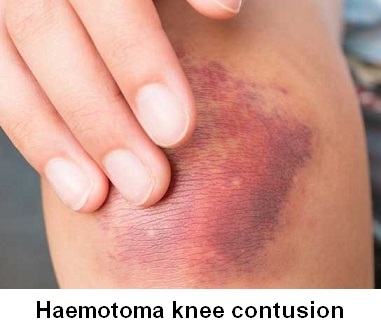
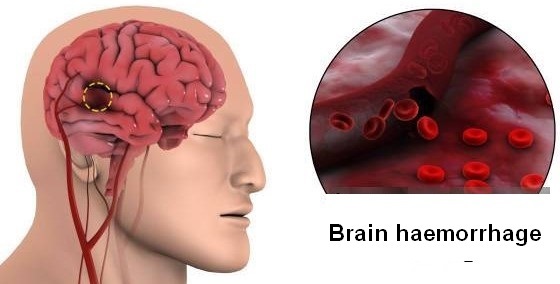 decoloración (moretón). Los hematomas leves son comunes, pero los hematomas más grandes pueden causar dolor, hinchazón o entumecimiento. Las lesiones en la cabeza pueden provocar hematomas internos (subdurales) con efectos graves, síntomas similares a los de un accidente cerebrovascular, como dolor de cabeza con dificultad para hablar, visión borrosa, mareos, problemas de equilibrio o
decoloración (moretón). Los hematomas leves son comunes, pero los hematomas más grandes pueden causar dolor, hinchazón o entumecimiento. Las lesiones en la cabeza pueden provocar hematomas internos (subdurales) con efectos graves, síntomas similares a los de un accidente cerebrovascular, como dolor de cabeza con dificultad para hablar, visión borrosa, mareos, problemas de equilibrio o
Debilidad en un lado. Los casos crónicos pueden causar pérdida de memoria, desorientación y, si no se tratan, parálisis, convulsiones o coma. Un coágulo de sangre en una vena se denomina trombosis venosa profunda, generalmente en la pierna. La hemorragia es un sangrado continuo proveniente de la rotura de un vaso sanguíneo, ya sea externo o interno. Todos los hematomas son resultado de hemorragias, pero no todas las hemorragias causan hematomas. 38,39
6. Donación de sangre: ¡un regalo precioso para otra vida!
Se necesita una transfusión de sangre cada pocos segundos en todo el mundo, a menudo por accidentes, complicaciones en el parto o enfermedades 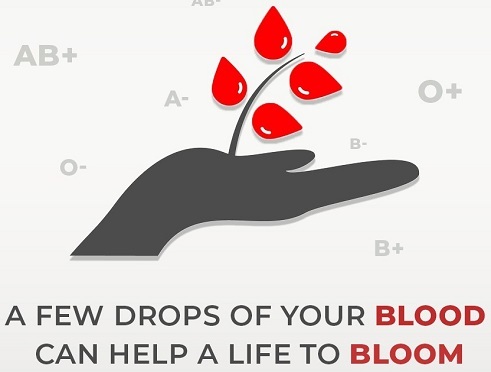 graves, y no existe un sustituto sintético (actualmente en investigación) para la sangre humana. Las directrices de la OMS recomiendan que los donantes tengan entre 18 y 65 años, pesen al menos 50 kg y gocen de buena salud, confirmada por médicos en los centros de donación. La sangre y el plasma donados se someten a pruebas exhaustivas para detectar enfermedades, lo que...
graves, y no existe un sustituto sintético (actualmente en investigación) para la sangre humana. Las directrices de la OMS recomiendan que los donantes tengan entre 18 y 65 años, pesen al menos 50 kg y gocen de buena salud, confirmada por médicos en los centros de donación. La sangre y el plasma donados se someten a pruebas exhaustivas para detectar enfermedades, lo que...
Los donantes regulares representan una protección sanitaria adicional. La donación de plasma también se promueve a nivel mundial, ya que contiene anticuerpos y proteínas vitales útiles para el tratamiento de diversas enfermedades. 40-44
Palabra Final: Mantenga su sangre sana, nútrala con un estilo de vida saludable, buena alimentación y hábitos puros; manténgase hidratado, evite adicciones dañinas, prevenga infecciones y lesiones y busque chequeos oportunos para cuidar su cuerpo como un regalo de Dios para el seva.
Referencias y enlaces
1. Sathya Sai Baba sobre las células sanguíneas: https://archive.sssmediacentre.org/www/ssspeaks/index/clips/?sid=127&cid=4&aid=19169
2. “Un corazón sano está en tus manos”, artículo de salud, boletín de Vibriónica julio-agosto de 2025, vol. 16, número 4, páginas 13-18, https://newsletters.vibrionics.org/english/News%202025-07%20Jul-Aug%20RG.pdf
3. Fundamentos de la sangre: https://www.hematology.org/education/patients/blood-basics
4. Sangre vital: https://my.clevelandclinic.org/health/body/24836-blood
5. Plasma: https://my.clevelandclinic.org/health/body/22865-plasma
6. https://www.stanfordchildrens.org/es/topic/default?id=que-es-plasma-160-37
7. GR: https://my.clevelandclinic.org/health/body/21691-function-of-red-blood-cells
8. Reciclaje de hierro en el cuerpo: https://pmc.ncbi.nlm.nih.gov/articles/PMC8469827/
9. Leucocitos: https://my.clevelandclinic.org/health/body/21871-white-blood-cells
10. Plaquetas: https://my.clevelandclinic.org/health/body/22879-platelets
11. Médula ósea: https://my.clevelandclinic.org/health/body/22818-bone-marrow
12. Médula ósea: https://www.medicalnewstoday.com/articles/285666
13. Células madre: https://byjus.com/biology/stem-cells/
14. Células madre: https://my.clevelandclinic.org/health/body/24892-stem-cells
15. El poder de las células madre: https://www.mayoclinic.org/tests-procedures/bone-marrow-transplant/in-depth/stem-cells/art-20048117
16. Análisis de sangre: https://my.clevelandclinic.org/health/diagnostics/24508-blood-tests
17. Hemograma completo: https://my.clevelandclinic.org/health/diagnostics/4053-complete-blood-count
18. https://www.mayoclinic.org/tests-procedures/complete-blood-count/about/pac-20384919
19, https://www.ncbi.nlm.nih.gov/books/NBK2263/table/ch1.T1/
20. https://www.maxhealthcare.in/blogs/prueba-completa-de-conteo-de-sangre-cbc
21. Artículo de salud sobre anemia y niveles de Hb: Boletín julio-agosto de 2018, https://news.vibrionics.org/en/articles/254
22. Tipos de sangre: https://my.clevelandclinic.org/health/treatments/21213-blood-types
23. https://www.redcrossblood.org/donate-blood/blood-types.html
24. Trastornos sanguíneos: https://my.clevelandclinic.org/health/diseases/24918-bone-marrow-failure
25. Hiperlipidemia: https://my.clevelandclinic.org/health/diseases/21656-hyperlipidemia
26. Hipoproteinemia: https://my.clevelandclinic.org/health/diseases/low-protein-in-blood-hypoproteinemia
27. Hemofilia: https://my.clevelandclinic.org/health/diseases/14083-hemophilia
28. Trastornos de los glóbulos rojos: https://www.medicalnewstoday.com/articles/red-blood-cell-disorders-types-causes-and-symptoms
29. Anemia de células falciformes: https://my.clevelandclinic.org/health/diseases/12100-sickle-cell-disease
30. https://www.mayoclinic.org/diseases-conditions/sickle-cell-anemia/symptoms-causes/syc-20355876
31. Talasemia: https://www.cdc.gov/thalassemia/about/index.html
32. Policitemia vera: https://my.clevelandclinic.org/health/diseases/17742-polycythemia-vera
33. Trastornos de los glóbulos blancos: https://my.clevelandclinic.org/health/body/21871-white-blood-cells
34. Leucemia: https://my.clevelandclinic.org/health/diseases/4365-leukemia
35. Leucopenia: https://my.clevelandclinic.org/health/diseases/17706-low-white-blood-cell-count
36. Trastorno de células plasmáticas de glóbulos blancos/Mieloma múltiple: https://my.clevelandclinic.org/health/diseases/6178-multiple-myeloma
37. Trastornos plaquetarios: https://my.clevelandclinic.org/health/diseases/platelet-disorders
38. Hematoma: https://my.clevelandclinic.org/health/diseases/21183-subdural-hematoma
39. Hematoma y hemorragia cerebral: https://www.ganeuroandspine.com/blog/brain-hematoma-vs-brain-hemorrhage-whats-the-difference/?post_type=blog_post
40. Donación de sangre: https://www.who.int/news-room/questions-and-answers/item/blood-products-why-should-i-donate-blood
42. https://www.who.int/campaigns/world-blood-donor-day/2019/who-can-give-blood
43/ Cómo funciona la donación: https://eraktkosh.mohfw.gov.in/eraktkoshPortal/#/
44. Todo tipo de donaciones de sangre: https://www.redcrossblood.org/donate-blood/how-to-donate/types-of-blood-donations.html
45. Guía de donación de plasma: https://www.plasmahero.org/news/whats-difference-between-blood-and-plasma-donation
_________________________________________________________________________________
2. Talleres y cursos celebrados en la oficina de SVIRT, Puttaparthi.
2.1 Curso virtual de seguimiento del SVP, 26 y 27 de julio de 2025
Con profunda dedicación a la misión de Swami, tres SVP 11635, 11646 y 03611 de la promoción de diciembre de 2024 presentaron con humildad sus historiales clínicos y registros médicos, todos tratados exclusivamente con tarjetas de simulador. A continuación, tuvo una fructífera conversación interactiva con sus profesores 10375 y 11422. Lamentablemente, la SVP 03590 de la misma promoción, aunque igualmente comprometida, no pudo asistir debido a que su madre se encontraba ingresada en la UCI.
El 27 de julio, varios otros entusiastas SVP de todo el mundo se unieron en línea para escuchar una inspiradora charla de nuestros fundadores, el Dr. Aggarwal y Hem Aggarwal. Entre los puntos destacados se incluyeron consejos sobre el uso moderado de miasmas para erradicar la enfermedad cuando otros remedios no logran resolver problemas crónicos persistentes; el poder único de la radiodifusión en situaciones donde el paciente se encuentra en estado crítico y no puede tomar remedios orales, tiene un problema de salud mental o vive lejos sin acceso a remedios; y el inmenso poder de la vibriónica cuando se practica con reverencia, oración concentrada y profunda fe. Los fundadores también compartieron algunas de sus experiencias con SRHVP en este contexto y aclararon con atención muchas preguntas de los participantes.
_________________________________________________________________________________
2.2 Taller de hindi y telugu 2.2 AP, del 31 de julio al 4 de agosto de 2025
Continuando con nuestro esfuerzo por llevar la vibriónica a áreas rurales y remotas, se organizó un taller de cinco días para seis nuevos participantes 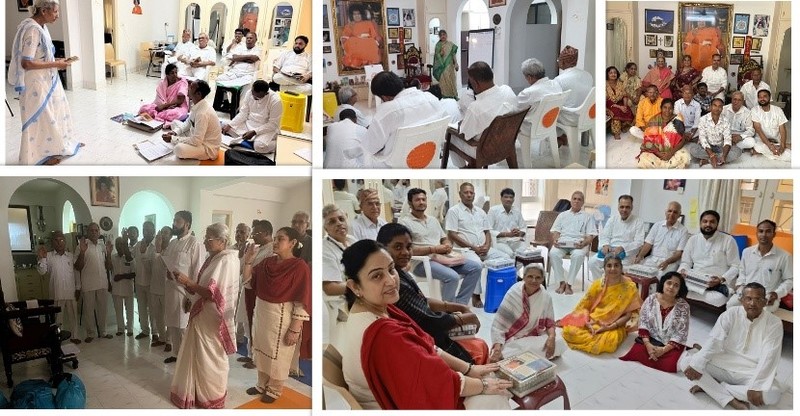 de todo el país, a los que se unió AVP 10879 , ansioso por actualizar sus conocimientos. Impulsados por una profunda pasión por servir a comunidades con poca o ninguna instalación médica, demostraron ser estudiantes entusiastas y dedicados. Incluso trajeron pacientes de áreas cercanas, agradecidos por la invaluable experiencia práctica. Bajo la estrecha guía de sus maestros, pudieron planificar remedios y administrarlos con confianza. Los dos maestros superiores 10375, 11422 , recibieron el apoyo de los practicantes 11573, 11567 , quienes gestionaron las admisiones y tradujeron documentos al hindi y al telugu. Los practicantes 11573, 11634, 11650 vinieron específicamente para brindar el apoyo muy necesario para el buen funcionamiento del taller.
de todo el país, a los que se unió AVP 10879 , ansioso por actualizar sus conocimientos. Impulsados por una profunda pasión por servir a comunidades con poca o ninguna instalación médica, demostraron ser estudiantes entusiastas y dedicados. Incluso trajeron pacientes de áreas cercanas, agradecidos por la invaluable experiencia práctica. Bajo la estrecha guía de sus maestros, pudieron planificar remedios y administrarlos con confianza. Los dos maestros superiores 10375, 11422 , recibieron el apoyo de los practicantes 11573, 11567 , quienes gestionaron las admisiones y tradujeron documentos al hindi y al telugu. Los practicantes 11573, 11634, 11650 vinieron específicamente para brindar el apoyo muy necesario para el buen funcionamiento del taller.
Los seis candidatos se clasificaron como AP, prestaron juramento y recibieron su sagrada caja de 108 CC. El último día, el Dr. Aggarwal pronunció un discurso inspirador, recordándoles que solo el poder divino reside en la bendita caja de 108 CC . Al compartir ejemplos de sus primeros días, les aseguró que Swami siempre da confianza a los nuevos practicantes al garantizar que los remedios funcionen, incluso cuando no se elijan a la perfección, y los animó a abrazar su deber de todo corazón, continuar tratando con fe y, si alguna vez se encuentran sin pacientes a pesar de sus mejores esfuerzos, rezar profundamente a Swami. Los instó a acercarse proactivamente, incluso si tienen que enviar remedios a lugares distantes. Además de esto, Hem Aggarwal recordó a todos que la caja de 108 CC está impregnada de las sinceras oraciones de quienes primero ayudaron a crearla, y luego bendecida abundantemente por el propio Swami.
Los participantes quedaron profundamente conmovidos por esta experiencia alegre aunque intensa y regresaron a casa con gran entusiasmo y un renovado sentido de propósito.
_________________________________________________________________________________
3. Anécdota - Del diario del Dr. Jit K Aggarwal - ¡De paciente a profesional: el salto de fe de una familia!
Eran los primeros días de nuestra trayectoria vibriónica: sin credenciales, con muy pocos conocimientos, poca experiencia, un registro irregular y sin directrices claras sobre a quién se le debía enseñar este sistema de sanación. Solo pedíamos una promesa escrita a Dios de practicar la vibriónica como seva y un mínimo de seis estudiantes por clase. Sin embargo, nuestra falta de estructura se compensó con nuestro entusiasmo inquebrantable, nuestra fe plena en los remedios y las abundantes bendiciones de Swami, reflejadas en resultados fenomenales. Un incidente memorable ocurrió en 1995.
Una noche, un niño estadounidense de 12 años entró en nuestra clínica con su padre. Había recibido tratamiento con antibióticos para una infección de garganta, pero en tan solo 16 horas después de tomar cuatro cápsulas, tenía todo el cuerpo cubierto de pústulas, granos y vesículas rojas. La familia estaba muy preocupada, ya que debían volar a casa en dos días. Su padre, médico, estaba convencido de que no se trataba de una reacción a los antibióticos, pero yo pensaba lo contrario. Potencié la cápsula a 200 °C para tomarla en el plazo de 3 días .
Al día siguiente, la mitad de las lesiones habían desaparecido y al día siguiente, todas las pústulas habían desaparecido. Les deseé un buen viaje, pero para mi sorpresa, confesaron que ya habían cancelado el vuelo y dijeron que habían decidido regresar a casa solo después de aprender vibriónica. Les expliqué que necesitábamos seis participantes para comenzar una clase. Esa misma tarde, la familia del niño, compuesta por cuatro personas, y otra pareja, se presentaron y me pidieron que comenzara el curso a la mañana siguiente. Una semana después, tras completar su formación y aprobar sus exámenes orales, las dos familias regresaron a casa con dos SRHVP en sus manos. Huelga decir que lograron resultados maravillosos, todo gracias a su firme fe y confianza en Swami.
_________________________________________________________________________________
4. En memoria
Con profundo pesar, anunciamos el fallecimiento de Philomina Joseph, 11972… India , 68 años, una dedicada profesional de Kerala. Falleció en paz el 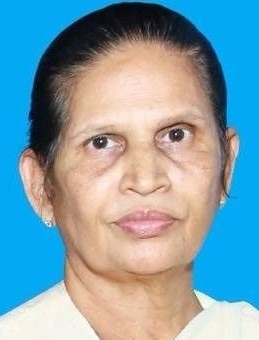 10 de agosto de 2025. Farmacéutica de profesión y maestra, nunca se casó y eligió una vida de servicio, dedicándose por completo al bienestar de los demás. Durante 12 años, recorrió 50 km diarios desde su pueblo hasta su clínica en Kasaragod, brindando su ayuda a quienes la necesitaban desde las 9:30 hasta las 15:00. Con compasión, sacrificio y devoción inquebrantable, conmovió a miles de personas, sirviendo hasta sus últimos días.
10 de agosto de 2025. Farmacéutica de profesión y maestra, nunca se casó y eligió una vida de servicio, dedicándose por completo al bienestar de los demás. Durante 12 años, recorrió 50 km diarios desde su pueblo hasta su clínica en Kasaragod, brindando su ayuda a quienes la necesitaban desde las 9:30 hasta las 15:00. Con compasión, sacrificio y devoción inquebrantable, conmovió a miles de personas, sirviendo hasta sus últimos días.
Su vida fue una verdadera encarnación del seva desinteresado y el amor incondicional. Una compañera practicante escribe: « Como una vela que se derrite para iluminar a los demás, entregó su vida en silencio al servicio de la humanidad». Que su noble alma descanse en paz y que su legado nos inspire a todos a servir con la misma dedicación.r legacy inspire us all to serve with the same dedication.
